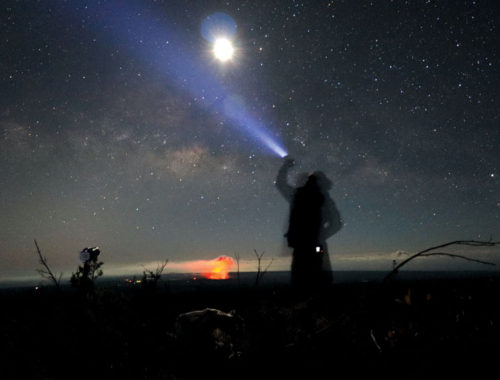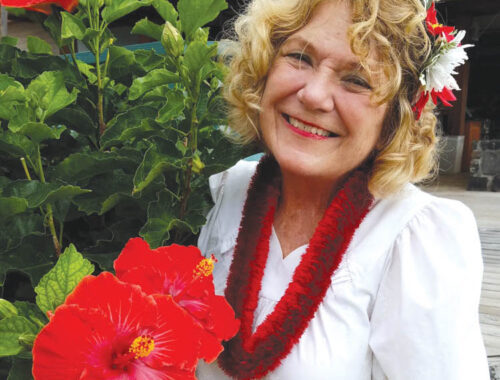Recalling the Majestic Palm in Art: Artist Shelley Hoist Partners with the Palm to Create Natural Beauty
By Karen Valentine
Who doesn’t love a palm tree? Swaying in a tropical breeze, it’s the stuff dreams are made of. Whether for a visitor or a local Hawai‘i resident, the palm tree is a living symbol of paradise. As the feathery palm frond moves back and forth in the breeze, it clings tightly to the trunk at the base by means of its sheath—a very strong piece of nature’s amazing creation. The tree naturally sheds each frond at the end of its cycle.
Local artist Shelley Hoist observes details, especially in nature, and imagines what she can make of something. Coming both from an artistic family and living frugally at times, Shelley, a 40-year Hawai‘i resident, has always found creative ways to make her surroundings beautiful. Her favorites are using elements from nature—a shell, an interesting branch or flower.
Stooping to pick up a large palm frond shed from a Royal palm tree, Shelley marvels at the unique grain, color and texture of its sheath. Not all palms have a sheath—for example the coconut palm. “Each variety of palm is different”, she says, and she has come to recognize the features of each, her favorites being Alexander, Royal and Foxtail. Her desire to capture that beauty and preserve it into something of value has led to an extensive body of work in the fine art of making sculptural and functional vessels using palm sheath as the medium. A business, Shelley Hoist Sculptural Palm Art, was born.
“It wants to be something else. It wants to go out and become this incredible piece of art. I love the uniqueness of the color and textures,” she exclaims.

on page 13.
The inside of each sheath has ridges or striations as well as patterns in shades of color, similar to the grain in wood. “It’s hard for me to keep my hands off of it. When I learned that different varieties of palms have different inner sheath colors, that was fascinating. It became a quest to make something with them, using different ones and experiencing how they reacted during the process.”
The basic process involves soaking the harvested sheath in a big tank of water until it becomes pliable.
“I love when I pull out a wet piece and lay it on the table, letting it speak to me. The other reason it seems to communicate to me is because it is of the earth. It’s been alive and now it will become sustainable, reusable. It is very strong, so much stronger than we think, and lends itself to a more permanent vessel. Once you wet it, form it and sculpt it, then watch it dry, it goes through this transformation; it becomes very, very solid. Some of the palm society people call it nature’s plastic, because it defies decomposition, especially in dry climates. It’s really durable and feels very much like heavy leather or fabric. Once it’s finished, it is preserved.”
Shelley began playing with palm sheath when a friend took a basket-making class and showed her the basics of soaking and forming the material, then stitching it with raffia or cord before it dries.
With increasing skill and attention to detail, Shelley has been able to raise the standards of working with natural fiber as art, from basic crafting to fine art worthy of winning awards in national juried shows.
“I am completely self-taught. I learned the basic technique and after that for many years I just played with the material, creating gifts and things for myself. Once I started devoting myself full time to the material, I developed new ways to use it and new techniques.”
The finished pieces of palm art consist of home décor including sculptural vessels that stand or hang on the wall, some functioning as containers and others making a statement alone. People may add dried branches for additional interest. Functional pieces can hold rolled up towels, fruit or collections. “Wall vases that hold a single flower with a glass tube inside to hold the water are a perfect way to bring the outdoors in,” Shelley says. The material isn’t waterproof, so it needs an inner jar or vase to hold live flowers. Certain vessels may be lined with fabric or trimmed with embellishments or other natural material. Shelley has also expanded beyond vessels into personal adornments such as jewelry, purses, hats and even costumes as she has become more and more experimental.
With the natural palm material as a partner in the process, Shelley starts asking it what it wants to be. “Once I get that raw material, I start listening; we start moving together, first through a series of folding and stitching it together by hand.
Slapping a wet sheath on her work table, Shelley goes to work, first drying it with a rag, then using a brush to scrub off any clinging debris. She examines the sheath, turning it in her hands, then trims the edge and crops the length with sturdy scissors. Working deftly while the material remains wet, her knowing hands measure, fold, and stitch a basic basket, tying knots deep inside the basket, and using her fingers to measure the distance between stitches made with a sailmaker’s needle and raffia fiber.
“Then over the course of about 48 hours, it starts to contract as the water evaporates,” she explains. “It will contract in certain areas so it starts to form a whole new sculptural shape, which I encourage or discourage. I control where it goes, but there is always an element of surprise. I’ve made an amazing piece out of something that was a surprise. After it’s dried, I then finish it with a hand-rubbed poly or encaustic wax finish and usually add embellishments, including foils and decorative papers. Sometimes organic textures are so wonderful, you don’t want to embellish it much. You have to know when to stop.”
She often makes use of feathers, leather, boar tusks, sheep horns—all elements that lend themselves to the natural expression of the art.
Fortunately, the raw material comes free, with no shipping charges. Neighbors and friends who have palm trees look for ways to dispose of their fallen fronds. It makes them feel good to know it will have another life.
“People share with me; there’s no shortage of raw material. Sometimes they might have a beautiful sheath from their land that I can make into a custom piece for them, something from their own yard, and elevate it to another level. I can incorporate natural elements and family keepsakes. Someone may have a special piece of coral or something they’ve found and we can work that into a piece,” she says.
“The more you create, the more your work changes. Soon it became evident that some of the pieces needed a name. I started to create pieces that have more of a story or a message; I call it intentional artwork. I reminded myself to be open to what that might represent. Natural and intentional art is wonderful to surround yourself with in your home. First, it’s visually pleasing, next it has organic texture, but thirdly, if it reminds you of a representation or a theme, that’s golden.”
One of the themes Shelley has worked with is called Passages. They are tall, narrow and elegant shapes.
“To me, they remind me of a palm tree trunk, standing tall with their roots in the ground, their strong narrow trunk, and reaching for the sky. That’s what the word passage means to me. The first one I created is called the Three Sisters. It is a set of standing passages all of different heights. When I first created the set and watched them dry, I realized they are like three sisters, all from the same family, but different. We need to respect the differences in each other, whether sisters, brothers or humans on Earth.”
After showing her work in galleries locally, such as Holualoa Gallery, and having a booth at the monthly Kokua Kailua Village Stroll, Shelley said, “Next I started looking for opportunities to take my work on the road. My Paniolo series, using naturally shed horns and leather, was created for the first opportunity I had to share my work on the mainland in a juried art show.”
The 2013 Western Design Conference in Jackson, Wyoming touts itself as the ‘preeminent exhibition of the finest Western design in the world.’ “It’s an amazing show. I came home with an award in the home accent category.”
After that experience, NICHE Magazine, featuring decorative art for galleries and fine retailers, chose Shelley Hoist as a 2014 NICHE Award finalist. In 2014, she returned to the Western Design Conference and also showed at the American Craft Council Show in San Francisco. On Hawai‘i Island, in fall of 2016, she was awarded “Best in Show” for a piece entitled Ho‘okumu at Kahilu Theatre’s “Art Off The Wall” Exhibit. Her award was the opportunity to mount her own exhibit at the theater’s gallery during November and December.
A unique and special component of Shelley’s palm artistry, which synchs well with her desire to make something custom and meaningful for her clients, is what she calls a Rest In Peace Memorial Urn Vessel. It “cradles” the ashes of a loved one in a natural, organic alternative to a traditional urn.
“The urn vessel is always lined. Some have tops that are removable, some open with a handmade bag on the inside that cradles the ashes. I often take a piece of clothing or fabric from the person, or line it with a material significant to them. The concept is something I’m very fortunate to discover. It’s an honor to make them. One example is a custom vessel created to hold a mother’s necklace given to her daughter. The basket holds the ashes and the necklace decorates the surface. It can be taken off and worn. It’s a neat way for mother and daughter to share that piece of jewelry,” she shares.
“Basically I think we’re our better selves, the more we connect with nature. When we incorporate organic textures into our home or on an office wall where you’re living with the items, touching them, seeing them—it helps us to reconnect and stay connected with nature.”
People may visit Shelley in her Kona studio by appointment.
Contact Shelley Hoist Sculptural Palm Art: shelleyhoist.com
Contact writer Karen Valentine: karenvalentine808@gmail.com


